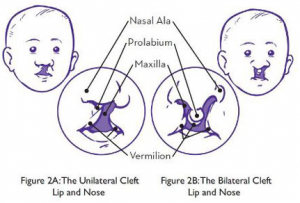Occurring in 1 in every 600 births, clefts are one of the most common birth defects in the US. Clefts form early on in pregnancy (between 4-8 weeks after conception) when the facial prominences (group of cells) are fusing together.
Three common types of clefts are as follows:
(1) Cleft Lip is when the tissues of the upper lip have incomplete formation, resulting in an opening in the lip. The opening can vary in size from a small split to a large gap (opening from lip to nose)
- Unilateral cleft is when the opening is on EITHER the left or the right side
- Bilateral cleft is when the opening is on BOTH the left and right side
(2) Cleft Palate occurs when there is an opening in the roof of the mouth. The roof of the mouth consists of the hard palate (bony portion near the front of the mouth) and the soft palate (composed of muscle and tissue in the back of the mouth).
(3) Submucous Cleft (SMC)
- SMC of the soft palate is characterized by insufficient muscular tissue and incorrect positioning of the muscles at the soft palate’s midline.
- SMC of the hard palate is when there is a notch/bony defect at the midline of the hard palate.
How are clefts detected?
Detection of a cleft can occur while a woman is still pregnant during a routine ultrasound depending on the severity of the cleft. If it is not detected during pregnancy, the cleft can be found after the child is born.
Submucous clefts may take longer to detect because the tissue layering the roof of the mouth covers the cleft making it difficult to see when looking in the mouth. Three ways to assist in detection include: abnormal nasal speech (sounds like the child is talking through his nose), presence/absence of a bifid uvula (a split in the piece of tissue that hangs in the back of the mouth), and/or a notch felt on the edge of the hard palate in the back of the mouth.
Why do clefts occur?
There are many possible causes of clefts. Two known causes include changes in genes (DNA from both parents) and gene-environmental interactions (what the mother is in contact with during her pregnancy). Genetic testing will help determine if the cleft is an isolated occurrence or if the cleft is associated with another disorder or syndrome.
It is important that a family schedule an evaluation with a multidisciplinary team at a Cleft-Craniofacial Clinic to identify the child’s needs. The team of professionals will outline a treatment plan specific to each child and provide the family with the necessary support systems.
My child has a cleft. What do I do now?
Many clefts can be corrected with surgery. This is why it is important to receive an evaluation with a Cleft-Craniofacial team. The team of professionals will determine the necessity and timeline of surgery depending on the age of the child and severity of the cleft. In addition, many children diagnosed with a cleft will need speech and language therapy. Therapy may be recommended after surgery, or to determine the need for surgery.
If your child is diagnosed with a cleft, it is very important to start therapy as early as possible to improve the child’s developmental skills that may be impacted by the cleft. The child will likely begin their therapy in Early Intervention (0-3) services. In Early Intervention, the child will receive an evaluation to identify the areas of development that are delayed.
Since clefts form in a child’s mouth, feeding/swallowing and communication are common areas of development identified. A speech and language therapist will come to the family’s home and assist them in teaching their child to develop oral motor functioning, make early developing sounds and build a vocabulary so he/she is able to communicate his/her wants and needs.
The speech language therapist will also help the family to monitor if the cleft has impacted the child’s hearing ability. Recurrent ear infections are a common indicator for concern. If the speech language therapist suspects the child’s hearing may be impaired he/she will recommend that the family receive a hearing evaluation by an audiologist and refer them to an ear, nose, and throat (ENT) doctor to evaluate the functioning of the middle ear.
In summary, having a child with a cleft can stir many emotions. Early identification will connect the family with proper support systems to help them cope with the mixture of feelings. In addition, early detection allows professionals to determine an optimal timeline for surgery and provides the family with the opportunity to begin therapy as early as possible so their child can reach all the necessary developmental milestones.
Resources:
American Speech-Language-Hearing Association website: Cleft Lip and Cleft Palate
http://www.asha.org/public/speech/disorders/CleftLip/#born
Cleft Palate Foundation
http://www.cleftline.org
Operation Smile
http://www.operationsmile.org/
Center for Disease Control and Prevention
http://www.cdc.gov/ncbddd/birthdefects/cleftlip.html#glossary


